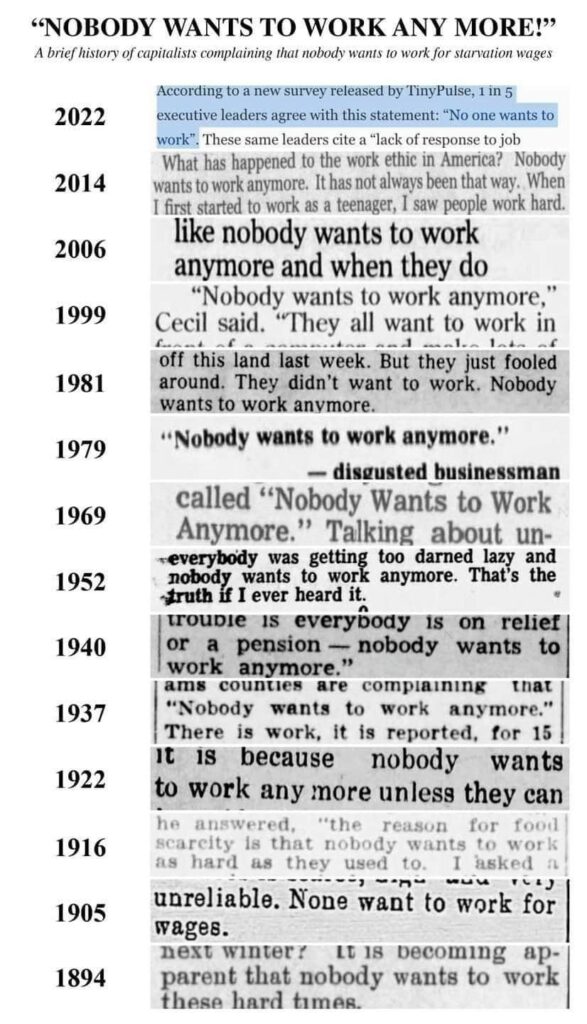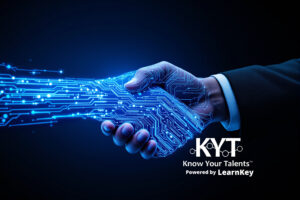

One of the biggest challenges business leaders face today is managing and engaging all the different generations in the workforce. It has been a huge research and conversation topic since the pandemic’s end.
With more generations in the workforce than ever in US history (five of them, to be exact), managers are dealing with a vast array of generational influences, values, communication styles, and motivations. Although the current workforce is the most extremely diverse one we’ve experienced, the challenge of “the generation gap” is nothing new. As early as 1894, folks were anguishing over the differences between older and younger workers!
The good news is that there are a great many benefits to generational diversity in the workforce, not the least of which is that it increases innovation; we just need to learn how to manage and engage employees from all generations as they learn to work together and create a unified team that produces brilliant work.
In this article, we briefly revisit the list of what makes each generation unique, share management tips, and offer a list of the benefits of maximizing your most valuable asset—your people!
Who’s Coming to Work?
As previously noted, five generations of the workforce are coming to the office and collaborating on various teams. They each come to work having experienced unique life/world events, having different parental generational influences, preferring different communication methods, relating differently to technology, and carrying their own values and priorities.
The wise and savvy business leader is aware of what each generation values, how they communicate, their expectations from work, and how they relate to technology. This knowledge and awareness helps them better understand why employees behave and prioritize what they do.
It’s not just at work that our generations differ. Because they grew up with different influences and under different world circumstances, they have their own challenges and priorities. Being aware of these is a must-have for effective leaders.
| Traditionalists | Baby boomers | Generation X | Millennials | Generation Z | |
|---|---|---|---|---|---|
| Birth year | Before 1946 | 1946–1964 | 1965–1980 | 1981–1996 | 1997–2012 |
| Communication | Prefer face-to-face interaction, formal emails, phone calls | Adaptable to various communication styles, including email and informal platforms | Value efficiency and directness, often prefer email and online platforms | Open to various communication styles, comfortable with digital platforms | Prefer digital platforms and instant messaging, value transparency |
| Technology | May require training and adaptation to newer technologies | Generally comfortable with technology, although some may need assistance | Highly adaptable to technology and often early adopters | Savvy with technology and prefer digital tools and collaboration platforms | Native digital users, comfortable with complex technology and innovation |
| Growth | Mentorship roles and sharing accumulated knowledge | Support for junior teammates’ development | Developing their team and using technology to make work easier | Opportunities to grow alongside the company | Career development |
| Financial | Retirement planning and financial stability | Wealth management and retirement preparation | Potential caregiving for both parents and children; debt repayment | Emergency savings and preparation for another possible recession | Income; student debt |
| Mental | Valuing certainty and stability | Uncertainty around retirement entering new stage of life | Job security during periods of economic disruption | Access to mental health resources | Burnout (and if their employer will address it meaningfully |
| Physical | Healthcare considerations and benefits | Rich health benefits, particularly chronic condition support | Work-life balance; physical fitness | Physical fitness (and subsidies that support it); family-building support services | Digital wellbeing apps and trackers |
| Social | Long-standing workplace relationships | Community and philanthropic involvement | Friendships both in and outside of work | Alignment of social values with employer’s | Social connection among colleagues; socially responsible organizations |
| Purpose | Legacy in professional field | Significant ties between job and identity | Job prestige; autonomy | Meaning in work | Alignment of ethics and values with employer’s |
| Values | Stability, loyalty, respect for authority, work ethic | Work-life balance, achievement, optimism, independence | Work-life balance, pragmatism, self-reliance, skepticism of authority | Collaboration, purpose, work-life integration, technology integration | Diversity, authenticity, entrepreneurship, social responsibility |
| Work expectations | Long-term employment, dedication to a single company, clear hierarchies | Career progression, recognition, meaningful work | Value flexibility, autonomy, and clear boundaries | Seek feedback, growth opportunities, and meaningful work | Seek flexible work arrangements, purpose-driven companies, and rapid learning opportunities |
Once we, as business leaders and people managers, grasp what makes each generation tick, it’s time to put to practice some important management styles and techniques.
How Do We Manage and Engage Them All?
The following five best practices are intended to be a source of inspiration for catalyzing age-friendliness, engaging the multigenerational workforce, and activating age-inclusive cultures (Collinson & Hodin, 2023; Kuligowski, 2024; Transamerica Institute, 2023; Transamerica Institute, 2023):
- Foster mixed-age teams. Encourage collaboration between older and younger employees to facilitate knowledge transfer and innovation, fostering a deeper understanding of company operations and promoting greater teamwork.
- Adapt communication styles. Recognize and accommodate diverse communication preferences across generations through email, instant messaging, phone calls, or face-to-face interactions.
- Recognize longevity and productivity. Implement a bonus program that rewards longevity and productivity, acknowledging the contributions of senior employees while appreciating the efforts of younger staff members.
- Establish clear expectations. Reduce misunderstandings within a multigenerational workforce by setting and enforcing clear expectations for interactions among employees, supervisors, and clients, minimizing conflicts and promoting a cohesive work environment.
- Prioritize age inclusivity. Ensure all employees feel valued and supported by promoting inclusivity in team-building events and corporate communications. Embrace age diversity in recruitment processes, including panel interviews, to showcase commitment to an inclusive workplace culture.
What About Training and Development?
In today’s dynamic work environment, it’s essential for workers to continuously update their skills and knowledge throughout their careers continuously. However, only a slim majority of employers prioritize professional growth for all employees, regardless of age. While some offer training programs and mentorships, there’s a notable lack of initiatives addressing generational differences and preventing age discrimination.
It’s more important than ever to offer your employees growth, learning opportunities, and resources. Some generations indicate that this is even more valuable to them than salary. With that in mind, employers must offer training and development in different formats. For example, you may want to provide one-on-one, hands-on training and make training available through mobile devices or online to engage your more technologically savvy employees.
One such notable practice is implementing a behavioral awareness system into every phase of the employee life cycle, from attraction, recruitment, and hiring to managing, career pathing, succession planning, and even exiting. Because behavior is predictable and “crosses” generations, it levels the playing field and unites people of all ages. For example, someone with high extroversion is a “people person” no matter what generation they are born in.
At Know Your Talents, we are proud to offer customized training, including live, in-person workshops, webinars, online courses, and one-on-one coaching to meet the varied needs of our clients and their multigenerational workforce. The foundation of all our solutions is a behavioral awareness system created by PDP Global.
What’s in It for the Business?
A multigenerational workforce can be highly beneficial for your business. Some upsides include the following (Kuligowski, 2024):
- A multi-gen workforce brings learning opportunities. Combining employees of different ages allows for sharing experiences, ideas, and thoughts, fostering effective problem-solving and creative solutions to company challenges.
- A multi-gen workforce fosters mentoring. Implementing a mentorship program matching employees across generations promotes team bonding and knowledge sharing, enhancing overall workplace collaboration.
- A multi-gen workforce lets you pool skills. Each generation contributes unique skill sets to the workplace, facilitating skill sharing among colleagues and boosting productivity and efficiency.
- A multi-gen workforce increases innovation. The diverse experiences within a multigenerational workforce generate a wide range of ideas, leading to increased team innovation. Drawing from five generations’ worth of perspectives enhances creativity in tackling company challenges.
A Robust Future
Our multi-gen workforce is here to stay. Although having so many generations in the workplace at once presents certain challenges, the benefits far outweigh them. The diversity of skills, communication styles, influences, and perspectives brings a robustness that we have not experienced before. Once we better understand each other and recognize the strengths of each generation, there is no limit to what we can innovate and build together.
References
Collinson, C. & Hodin, M. (2023, October 17). Best practices for engaging a multigenerational workforce. Harvard Business Review. https://hbr.org/2023/10/best-practices-for-engaging-a-multigenerational-workforce
Great Socialist Cats. (2022, July 20). 130 years of “no one wants to work anymore.” [Image]. Facebook. https://www.facebook.com/greatsocialistcats/photos/a.294692847648287/1480687955715431
Kuligowski, K. (2024, January 3). Managing Tips for a Multigenerational Workforce: From Baby Boomers to Gen Z. Business.com. https://www.business.com/articles/hiring-multigenerational-workforce/
Transamerica Institute. (2023, May 2). Stepping into the future: Employers, workers, and the multigenerational workforce. https://transamericainstitute.org/workplace-employers/employer-research#employerworkerdisconnect
Transamerica Institute. (2023, July). Post-pandemic realities: The retirement outlook of the multigenerational workforce. https://transamericainstitute.org/docs/default-source/research/post-pandemic-retirement-realities-multigenerational-workforce-report-july-2023.pdf


